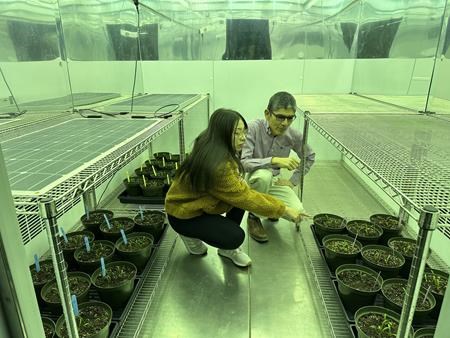Alberta
‘More connected’: Researchers looking at growing food under solar panels

EDMONTON — Lawns, backyards and roofs could be used to produce both solar power and fresh vegetables, University of Alberta researchers say.
Guillermo Hernandez, a soil scientist, and Camila Quiroz, a research intern from Peru, are looking into growing crops under solar panels to improve the use of space in cities and farms.
“We know how to generate electricity from sunlight. We also know how to grow crops,” says Hernandez. “But the question is, can we do the two things in the same space?”
Crop harvesting under solar panels is called agrivoltaics, a relatively new concept to improve land-use efficiency by producing energy and food in the same spot.
In a 25-day experiment, Hernandez and Quiroz grew batches of spinach under three systems — thick solar panels, thin solar panels and without solar panels.
The researchers used simulated sunlight in a small room at the university during the Alberta winter.
Quiroz, who is studying energy engineering in Peru, says there weren’t any significant differences in taste or nutrition between the spinach grown under solar panels and the batch grown under simulated sunlight.
“I ate some of the solar panel-grown spinach,” Quiroz says. “They were sweet. The taste was perfect.”
However, the solar panel-grown plants were smaller than the batch grown without the panels.
Quiroz says a “little more time” under the panel would help them mature better.
The researchers are conducting a lab analysis to determine the exact nutritional composition of the three batches, and will be publishing the results in the coming weeks.
Quiroz says agrivoltaics is about more than just optimizing land area.
Solar panels create a microclimate underneath them, shielding plants from direct sunlight and fostering the right temperatures. Greens, berries and broccoli are among the foods that grow well under solar panels.
Quiroz says solar panels could also contribute to higher crop production for certain foods and improve water efficiency.
“Another benefit is the increase the solar energy generation,” Quiroz says.
An International Energy Agency report this year said investors are increasingly gravitating towards solar-powered projects, outpacing the spending on fossil fuel projects for the first time.
Hernandez says even though the initial cost of installing solar panels could be high, agrivoltaics has the potential to become a part of the urban landscape in Canada.
“The connection with food is missing in some urban areas.”
He says agrivoltaic farming would teach people to grow fresh produce while harnessing solar energy on balconies, backyards and smaller areas.
“People will be able to witness growing their own food, and they will feel more connected to where their food is coming from.”
Some provincial governments have been giving rebates and grants to households and institutions for installing solar panels.
Other countries, including South Korea and France, are also experimenting with agrivoltaics.
Hernandez says the next step is to secure funding for research on other vegetables and explore how solar panels work outdoors and at differing heights and angles.
He is also working on a guide for agrivoltaic farming, which would include a list of crops that can be grown under solar panels.
This report by The Canadian Press was first published May 27, 2023.
—-
This story was produced with the financial assistance of the Meta and Canadian Press News Fellowship.
Ritika Dubey, The Canadian Press
Alberta
Alberta takes big step towards shorter wait times and higher quality health care

From the Fraser Institute
On Monday, the Smith government announced that beginning next year it will change the way it funds surgeries in Alberta. This is a big step towards unlocking the ability of Alberta’s health-care system to provide more, better and faster services for the same or possibly fewer dollars.
To understand the significance of this change, you must understand the consequences of the current (and outdated) approach.
Currently, the Alberta government pays a lump sum of money to hospitals each year. Consequently, hospitals perceive patients as a drain on their budgets. From the hospital’s perspective, there’s little financial incentive to serve more patients, operate more efficiently and provide superior quality services.
Consider what would happen if your local grocery store received a giant bag of money each year to feed people. The number of items would quickly decline to whatever was most convenient for the store to provide. (Have a favourite cereal? Too bad.) Store hours would become less convenient for customers, alongside a general decline in overall service. This type of grocery store, like an Alberta hospital, is actually financially better off (that is, it saves money) if you go elsewhere.
The Smith government plans to flip this entire system on its head, to the benefit of patients and taxpayers. Instead of handing out bags of money each year to providers, the new system—known as “activity-based funding”—will pay health-care providers for each patient they treat, based on the patient’s particular condition and important factors that may add complexity or cost to their care.
This turns patients from a drain on budgets into a source of additional revenue. The result, as has been demonstrated in other universal health-care systems worldwide, is more services delivered using existing health-care infrastructure, lower wait times, improved quality of care, improved access to medical technologies, and less waste.
In other words, Albertans will receive far better value from their health-care system, which is currently among the most expensive in the world. And relief can’t come soon enough—for example, last year in Alberta the median wait time for orthopedic surgeries including hip and knee replacements was 66.8 weeks.
The naysayers argue this approach will undermine the province’s universal system and hurt patients. But by allowing a spectrum of providers to compete for the delivery of quality care, Alberta will follow the lead of other more successful universal health-care systems in countries such as Australia, Germany, the Netherlands and Switzerland and create greater accountability for hospitals and other health-care providers. Taxpayers will get a much better picture of what they’re paying for and how much they pay.
Again, Alberta is not exploring an untested policy. Almost every other developed country with universal health care uses some form of “activity-based funding” for hospital and surgical care. And remember, we already spend more on health care than our counterparts in nearly all of these countries yet endure longer wait times and poorer access to services generally, in part because of how we pay for surgical care.
While the devil is always in the details, and while it’s still possible for the Alberta government to get this wrong, Monday’s announcement is a big step in the right direction. A funding model that puts patients first will get Albertans more of the high-quality health care they already pay for in a timelier fashion. And provide to other provinces an example of bold health-care reform.
Alberta
Alberta’s embrace of activity-based funding is great news for patients

 From the Montreal Economic Institute
From the Montreal Economic Institute
Alberta’s move to fund acute care services through activity-based funding follows best practices internationally, points out an MEI researcher following an announcement made by Premier Danielle Smith earlier today.
“For too long, the way hospitals were funded in Alberta incentivized treating fewer patients, contributing to our long wait times,” explains Krystle Wittevrongel, director of research at the MEI. “International experience has shown that, with the proper funding models in place, health systems become more efficient to the benefit of patients.”
Currently, Alberta’s hospitals are financed under a system called “global budgeting.” This involves allocating a pre-set amount of funding to pay for a specific number of services based on previous years’ budgets.
Under the government’s newly proposed funding system, hospitals receive a fixed payment for each treatment delivered.
An Economic Note published by the MEI last year showed that Quebec’s gradual adoption of activity-based funding led to higher productivity and lower costs in the province’s health system.
Notably, the province observed that the per-procedure cost of MRIs fell by four per cent as the number of procedures performed increased by 22 per cent.
In the radiology and oncology sector, it observed productivity increases of 26 per cent while procedure costs decreased by seven per cent.
“Being able to perform more surgeries, at lower costs, and within shorter timelines is exactly what Alberta’s patients need, and Premier Smith understands that,” continued Mrs. Wittevrongel. “Today’s announcement is a good first step, and we look forward to seeing a successful roll-out once appropriate funding levels per procedure are set.”
The governments expects to roll-out this new funding model for select procedures starting in 2026.
* * *
The MEI is an independent public policy think tank with offices in Montreal, Ottawa, and Calgary. Through its publications, media appearances, and advisory services to policymakers, the MEI stimulates public policy debate and reforms based on sound economics and entrepreneurship.
-

 Bruce Dowbiggin2 days ago
Bruce Dowbiggin2 days agoBettman Gives Rogers Keys To The Empire. Nothing Will Change
-

 2025 Federal Election2 days ago
2025 Federal Election2 days agoPoilievre Will Bring in ‘One and Done’ Resource Approvals, and Ten Specific Projects Including LNG Canada Phase II
-

 conflict1 day ago
conflict1 day agoZelensky Alleges Chinese Nationals Fighting for Russia, Calls for Global Response
-

 2025 Federal Election1 day ago
2025 Federal Election1 day agoHarper Endorses Poilievre at Historic Edmonton Rally: “This Crisis Was Made in Canada”
-

 2025 Federal Election8 hours ago
2025 Federal Election8 hours agoCommunist China helped boost Mark Carney’s image on social media, election watchdog reports
-

 2025 Federal Election1 day ago
2025 Federal Election1 day agoMark Carney’s radical left-wing, globalist record proves he is Justin Trudeau 2.0
-

 2025 Federal Election2 days ago
2025 Federal Election2 days agoElection Security Briefing Confirms CCP-Linked Operation Boosted Carney
-

 2025 Federal Election1 day ago
2025 Federal Election1 day agoAn In-Depth Campaign Trail “Interview” With Pierre Poilievre










